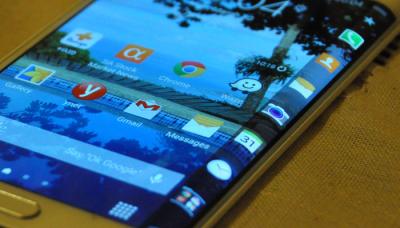Super AMOLED: introduction and market status
OLED displays use organic materials that emit light when electricity is applied. OLEDs enable emissive, bright, thin, flexible and efficient displays. OLEDs are replacing LCDs in most display applications - from smartphones and wearables to monitors and TVs.

Samsung's Super AMOLED displays, announced in 2010, are AMOLED displays for mobile devices (such as smartphones, wearables and tablets) with an integrated touch function. The thickness of the touch sensor is just 0.001 mm and this allows the screen to provide better images and to have great visibility even in direct sunlight compared with regular AMOLED displays with an external touch layer.
Samsung is producing hundreds of millions of Super AMOLED displays today, used mostly in smartphones, but also in other devices. These are considered to be some of the best displays on the market.
Super AMOLED and the Pentile matrix
Samsung's Super AMOLED displays use a Pentile matrix sub-pixel design. That means that the green sub-pixel is shared by two pixels and the display has only 2 sub-pixels per real 'pixel' compared to the classic RGB matrix design (or Real-Stripe). You can see a PenTile matrix vs a Real-Stripe one on the images below (the PenTile is on the right). Newer Super AMOLED displays use a different PenTile matrix (Diamond Pixel pattern).
Super AMOLED vs Dynamic AMOLED
In 2019 Samsung introduced its next-generation mobile display technology, which it calls Dynamic AMOLED. Basically a Dynamic AMOLED is similar to a Super AMOLED display, but it adds HDR support. Samsung's highest end smartphones adopt the company's Dynamic AMOLED 2X LTPO AMOLED displays.
Further reading
- Introduction to OLEDs
- Samsung's OLED displays
- Pentile Technology explained
- Flexible OLEDs
- OLED mobile phones
- The OLED Toolbox: a one-stop-shop for OLED information, insights, analysis and guides
Nokia announces three new AMOLED phones - the E7, C6-01 and the C7
Update: There are actually three new phones, the C6-01, C7 and E7.
Nokia has just announced three new Smartphones - the E7, C6 and the C7. All use AMOLED touch displays. The E7 has a 4" display, the C7 a 3.5" one and the C6 a 3.2" one. The E7 and C6 displays use Nokia's new ClearBlack Display technology (CBD) - which is said to deliver better outdoor visibility.

The phones will be released towards the end of 2010, in Europe. The E7 will cost â¬495, the C6 will cost â¬260 and the C7 will cost â¬335.
Samsung updates on AMOLED displays
Samsung (or actually Lee Woo-Jong, SMD's marketing VP) is giving us some interesting updates on their AMOLED displays and production plants. So first of all, they expect the new 5.5-Gen plant to start mass producing in July 2011. The new plant will increase Samsung's AMOLED capacity ten-fold: from 3 million displays a month to 30 million (assuming all displays made in the new plant will be around 3").

Samsung also says that they now expect AMOLED screens shipments to reach 700 million by 2015 (in May, they said it'll be 600).
Samsung: Super-AMOLED is best-in-class, but the Tab uses S-LCD because of price, supply and efficiency
A Samsung executive talks about the Galaxy Tab display. He said that while Super-AMOLED is the best-in-class display, they are using S-LCD because it's cheaper, there's no supply issues, and it's actually more efficient than AMOLEDs currently (that's not the first time we hear this).
The good news is that next year we're expecting AMOLED supply to rise sharply. And Samsung are planning to double the efficiency of their AMOLED displays soon.
Samsung's Galaxy-Beam projector phone shown at the IFA 2010
Remember Samsung's Galaxy Beam? Samsung is showing this projector-phone (launched in July in Singapore) at the IFA 2010 show. Hopefully this means that a European release will be announced soon... The Galaxy Beam has a 3.7" Super-AMOLED, WVGA DLP pico-projector, Android v2.1, Wi-Fi, 8mp camera, A-GPS, FM radio and HD video recording.
The Samsung Epic 4G is one Sprint's best-selling devices for first-day sales
A few days ago we reported that Sprint was pleased with the first-day response of the Epic 4G phone. Now Sprint says that the phone "became one of Sprint's best-selling devices for first-day sales". There still won't give exact sales numbers. The Super-AMOLED display is one of the phone's major selling point, according to Sprint: "With its beautiful Super AMOLED touch-screen, full QWERTY keyboard and two cameras, Samsung Epic 4G is a terrific smartphone that delivers the promise of the Sprint 4G network".

The Galaxy Tab is official - with a 7" TFT-LCD
Samsung has officially launched the Galaxy Tab today - and it has a 7" TFT-LCD display. Even though we had rumors of a Super-AMOLED display for months, an LCD was expected. Like we posted earlier today: Samsung can't keep up with AMOLED production demand as it is, and there's no way they can use OLEDs in new devices.
 Samsung Galaxy S and Galaxy Tab
Samsung Galaxy S and Galaxy Tab
Beside the 7" TFT-LCD 9that has a 1024x600 resolution, by the way), the Tab runs Android 2.2 on a 1Ghz A9 processor, has 16/32GB of internal memory and a microSD slot, 1.3mp front camera and a 3mp rear camera, 3G for data and voice (but no earpiece - you have you use bluetooth or a speakerphone), Wi-Fi and Full-HD video playback.
Sprint is pleased with the first-day sales of the Epic 4G
Sprint Nextel said it was pleased with the first-day response of the Epic 4G phone. They didn't give any sales numbers though. The Samsung Epic 4G phone costs $199 (with a new contract). The Epic 4G is a 1Ghz Android (v2.1) QWERTY slider for Sprint's WiMax network. It has a large (4") Super-AMOLED, 5mp camera (capable of 720p video recording), 802.11b/g/n WiFi and a six-axis accelerometer.

Samsung's Epic 4G now selling for $199 (with a Sprint contract)
Sprint has started selling the Samsung Epic 4G phone for $199 (with a new contract). The Epic 4G (or Galaxy Pro) is a 1Ghz Android (v2.1) QWERTY slider for Sprint's WiMax network. It has a large (4") Super-AMOLED, 5mp camera (capable of 720p video recording), 802.11b/g/n WiFi and a six-axis accelerometer.

Samsung sold over a million Galaxy S phones in the US in 45 days (AT&T and T-Mobile)
Samsung say that they have sold over a million Galaxy-S phones in the US - in just 45 days. The phone started shipping on July 15, and is currently available for AT&T and T-Mobile (it will soon be available with Sprint, Verizon, U.S. Cellular and Cellular South). Amazon are now offering it for AT&T at no cost (with a new plan), It is now AT&T's best selling phone in Amazon!. The Galaxy-S, Samsung's latest Android phone, has a 1 Ghz processor and a large 4" Super-AMOLED display.
The Galaxy Tab probably uses a LED-LCD, not a Super-AMOLED
Engadget has posted a short video showing a preview of Samsung's Galaxy Tab tablet computer. So it's not official yet, but according to the video, it has a LED-LCD, not a Super-AMOLED. We'd obviously love Samsung to release a tablet with an AMOLED, but realistically it's unlikely - they can't keep up with current demand of small AMOLEDs for mobile phones...

Pagination
- Previous page
- Page 22
- Next page




